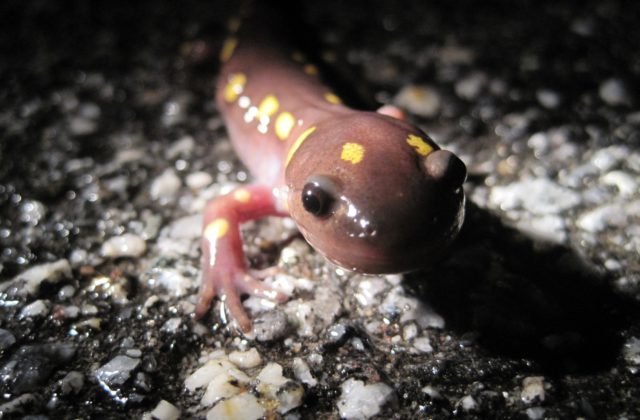Community Based Conservation of Migratory Amphibians
It’s Only Natural
By Martha Klein
In our highly mobile society, there are four million miles of roads and 200 million vehicles, so it’s not surprising that there are several million deaths of vertebrates every year on United States roads. For some species of animals, roadkill can take out 20 percent or more of their population annually. For threatened or endangered animals, this loss of population can lead to local extinction, or extirpation.
Slow moving reptiles and amphibians are at particular risk, as are large mammals which must cross roads repeatedly in their expansive territories. Each spring, many species of salamander and other amphibians make a yearly trek to their natal vernal pool or other wetland to breed, frequently crossing roads to get there. The thousands killed during this migration have a measurably negative effect on their population and survival prospects. Of the threatened or endangered amphibian species which live in the Norfolk area, two are spring migrants: the Blue-spotted Complex and the Jefferson Complex Salamanders.
Concern about the impact of roads on wildlife and the natural environment has increased, driven in part by recognition of the significant impact of road fatality on endangered or threatened species, as well as by the need to reduce the increasing number of wildlife-vehicle collisions. Every state and many countries have modified a transportation project to allow for safe passage or breeding of wildlife, ranging from simple modifications like new road signs, to the construction of large animal overpasses, or ecoducts.
Animal underpasses have proven effective at reducing wildlife-vehicle collisions and reducing the rate of animal fatalities by 58 percent, primarily for mammals, according to a 2010 study published in the Journal of Wildlife Management. In our state, the Department of Transportation built a nesting box for a Peregrine Falcon pair who nested under a bridge in Bridgeport that was to undergo construction. The couple hatched two nestlings in their created nest.
Similarly, a local intervention by the Farmington River Watershed Association in 2006 modified stream flow under a bridge on the Sandy Brook to facilitate the movement of fish to important upstream habitat. Although roads and other large infrastructure most commonly impact animals and their environment negatively, there is now increasing awareness and more opportunities to minimize harm during road repair and construction projects.
Numerous states have modified culverts or even built salamander tunnels to allow safe passage for amphibians. These states include Vermont, New Hampshire, Massachusetts, New York, New Jersey, Virginia and Oregon. Due to amphibians’ unique requirements of moisture, moderately cool temperatures and low, ambient light to make their migration, they travel only on rainy, cool nights in early spring. They will not use passages that are completely dark, dry, or lack leaf litter. Therefore, the most effective tunnels have slots on top to allow in rain, low light and leaves.
The Henry Street Tunnels in Amherst, Massachusetts were the first dedicated amphibian passages in the United States and have helped thousands of salamanders to cross since 1987. The rate of successful crossing through the tunnels is about 75 percent, while the rate of survival for amphibians crossing busy roads can be near zero. Other modifications which are not amphibian specific are less successful. For instance, in Oregon, rock ledges built inside culverts to help with passage are usually dry and exposed, so they are used primarily by small mammals and a couple of frog and turtle species.
There are local organizations, like the Connecticut Amphibian Monitoring Project, that monitor vernal pools and take inventories of amphibians, but there has never been an amphibian watch program in Connecticut to determine areas of high density migrations, and to help animals successfully cross, until now. Aton Forest is starting a new citizen science project to monitor the amphibian migration, and to train volunteers who wish to learn how to help amphibians cross roads.
On Saturday, March 17, from 3 to 5 p.m., Aton Forest is hosting Salamander Crossing Guard Training at its headquarters on North Colebrook Road. The training session is free and open to the public (ages 12 and over). The training is provided by The Harris Center for Conservation Education, whose Ashuelot Valley Environmental Observatory (AVEO) program is a leader in coordinating Salamander Crossing Guard Brigades in southwest New Hampshire. AVEO volunteers have helped cross over 11,000 animals since 2006, and their data have been instrumental in protecting land at a locally significant amphibian crossing.

